Additional Information about Madrid

With a meanful employment of the public means of transportation and a little planning, also a short visit to Madrid will get diversified and nice. In the following I will mention some information about the traffic and about some recommendations for having a walk in Madrid.
Traffic in Madrid
As it is the case in almost every capital of Europe, the traffic of Madrid can be very chaotic; Although the net of the public transportation is very well arranged, a large part of the inhabitants have one or more cars and move with them through Madrid. But many also own a car in order to move outside Madrid; for the inner city transportation, they use the public means of transport.
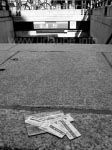
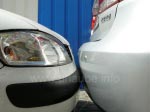

It is not recommendable to explore Madrid with a rented car - the very high parking fees, lack of parking places and the partly chaotic and dangerous driving style of the Madrileneans induce to better make use of the public transportation.
In Madrid, one sees a lot of pedestrians - but nearly nobody is riding a bike. This is due to the reasom that in Madrid, depending on the situation, many places are comfortably reachable on foot; but bike paths are scarce and only outside the centre. But if one sees a biker, most of the times, he is wearing a helmet, a luminuous waist coat and is very well equiped with more protective clothes. It is also possible to rent a bike and for example explore the Casa de Campo by this Way.
Public means of Transportation
The airport named Aeropuerto de Madrid Barajas is located at approximately 12 kilomeres distance from the city and it is very easy to get to by subway (Aeropuerto T1-T2-T3 or Aeropuerto T4, both L8). Another possibility is to get with the airport shuttle up the the subway and bus station Avenida de América (L4, L6, L7, L9) and to continue from there by subway. The second option is, depending on where one wants to get to, more comfortable instead of changing several times.
The trip to the airport has to be paid with a second ticket - even though one only uses the subway - except one owns a monthly ticket or a tourist ticket. This tourist ticket is very useful and one should in any case get it already at the first subway station, as with it, one can use the whole traffic system as much as wanted for a certain amount of days.

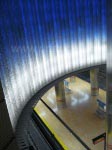
The subway net is very clear, despite of its abundance of subway lines. The subway is probably the most easy means of traffic in order to get orientated and to get everywhere. But from 01.30 a.m., no subway is active anymore, so that one is forced either to go by foot, take a taxi or the night bus - the Buho ("Owl").
I never took a taxi, but I heard that the prices for a taxi trip are quite moderated. One should only pay attention that the taximeter is activated and to negotiate the price before starting the trip. The buhos can be used with the tourist card without having to pay any surcharge; but one should get previously informed at which stop one has to get out. Many times, the bus drivers are very nice and one can ask them to tell one when one should get out.
The bus system is aligned to the subway system and one gets to some places faster thn with the subway. But here, the problem is that one should already know the city a little in order not to get lost. In order to get to those places that are a little outside the city, on can use the Cercanía, the short distance train that stops for example at the stations ,Atocha (subway linie 1), Príncipe Pio (subway line 6 nd 10) and others.
At these subway station nd others, as for example Chamartín (subwy lines 1, 10), one has the possibility to continue by train. But is generally applies that the trains are more expensive than the buses. One also has the possibility to travel to other Spanish cities by bus. A part of the trips are subsidized so that the prices are quite reasonable. The buses to the other cities depart from the bus stations of the Avenida de América (L4, L6, L7, L9), Méndez-Álvaro (L6) and Príncipe Pío (L6, L10).
Tours through Madrid
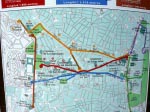
Sometimes, one will come across in Madrid to sign with tourist informations for suggested tours in the city centre. All of them include different sightseeings, but these all in tours can be surely arranged in more individual way.
From the bustling Plaza de Cibeles to the Retiro, the most famous Park of Madrid
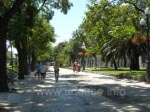

The first tour has a length of 1370 m and starts at the Plaza de Cibeles (subway Banco de Espaņa, L2) and leads in direction to the Biblioteca Nacional. The promenade with the shady plants is very nice. One passes the Jardines del Descubrimiento that remind on the discover of America. Then, the path leads further to the Museo Arqueológico and ends at the Puerta de Alcalá. Once arrived there, one can either have a relaxing walk or a siesta in the Retiro (be careful with the thiefs!).
The Paseo del Prado: The Art Mile of Madrid
The second tour is one of the most popular ones: The Paseo del Prado that was built between the years 1775 and 1782. José de Hermosilla, Juan de Villanueva and Ventura Rodríguez took part on this building and the relization of it. One can start at the Palacio de Comunicaciones and/or at the Plaza de Cibeles and walk towards the Museo Nacional Centro de Arte Reina Sofía or just the way around, starting at the Reina Sofía. The advantage of the just mentioned option is that one can do the tour from the Plaza de Cibeles and afterwards the first tour up to the Puerta de Alcalá. But the combination of both tours is very exhausting in the heat, so that one better considers the buildings to be visited.
Departing from the Museo Reina Sofía at the subway station (L1), one can first have a look into the tropical station hall and afterwards get to the arts museum Reina Sofía, before continuing to the promenade of the Paseo del Prado. The Jadin Botánico is absolutely recommendable and also suggested by the city Madrid - a small oasis in the eastern centre. At its Entrance, some soft guitar tones of the Ave Maria sound. Tee Spaniard Julio plays since many years at the sme place, mainly in the week ends.
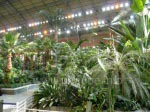

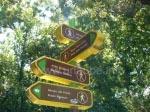
Right beside there is the Prado, at which always crowds of people cavort and take some pictures and people stand there and sell some oil paintings. Depending on how intensively one wants to visit the three museums of the "art mile", one should think about visiting all three museums shortly or for example plan a separate day for the Prado. The city of Madrid considers in its recommendation a side trip to the Retiro, but I would preferrably abstain from this. It is much better to walk on the Paseo del Prado and experience one or two museums and go at the end to the Retiro Park, in order to see more of the park and to schedule the tour better.
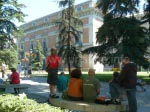
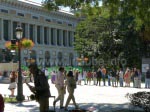
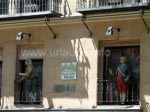
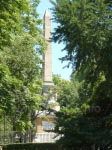
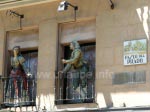
At the Plaza de Cánovas del Castillo in the proximity of the Prado there is the impressive Neptun-fountain that was arranged in the year 1780 by Juan Pascual de Mena; Right in the proximity, there is the Palacio de Villahermosa that accommodates the Museo Thyssen-Bornemisza and the Congreso de los Diputados (the Spanish Parliamnt Building).
The way continues on the green middle strip of the paseo to the Plaza de la Lealtad, at which the Obelisk de 2-del-mayo as remembrance to the 2nd of May 1808 is visible. The stock exchange is in the proximity that was built in the year 1884. This is the perfect area for a short relaxtion, as the avenues are shady and despite of the traffic, one is a little isolated.
Passing the Apollo-fountain, one finally gets to the Plaza de Cibeles, one of the traffic junctions of Madrid. Those who have still some energy can have a further walk - or simple get by subway to another place, as we finally have made 2120m (the museum visits excluded).
From the Calle Alcalá at the Templo de Debod: A Way through the Metropolis with an Egypt Destination
The third tour leads, with a length of 2900m, from the Calle Alcalá and Gran Vía (Plaza de Cibeles, Metro Banco de Espaņa, L2) to the Plaza Callao finally to the the Plaza de Espaņa and to the Templo de Debod. This destination is surely worthwhile to visit; but I would shorten the walk insofar that I would only walk on a part of the Gran Vía, but I would in any case avoid t walk aver the whole street that is a synonym for the crowds, shops and traffic. Contrary to the other tours, the Gran Vía generaly shows some buildings of the same style, so that one should distribute one's time in a different way.
From the Traffic Junction of the Plaza Cibeles to the Royal Palace
A diversified walk across the centre is the fourth tour of a length of 1690m, starting at the Plaza de Cibeles (Metro Banco de Espaņa, L2). One passes the Academia de Bellas Artes and can do a side trip to the Monasterio de las Descalzas Reales and visit the church San Gínes. The end is the Teatro Real and the Plaza Oriente; depending on the time, one can include the Palacio Real and the Jardínes Sabatini.
A Glance through the Centre
The fifth route leads, as the fouth tour, through the centre and starts at the Plaza de Cávonas del Castillo. One passes the Congreso de los Diputados and gets into the core of the city: to the Puerta del Sol, point of attraction of all the tourists and this is exactly the reason why it is the point of attraction for many beggars. Through the Calle Mayor, one continues to the Plaza de la Villa and to the Muralla Árabe, the Arabian wall in the proximity of the Cathedral. On this tour of a length of barely 2010m one sees - as it is the case in the fourth tour - a lot from the centre, a thing that is worth the effort and transmits the first glance.
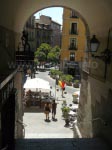
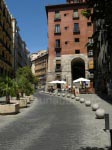
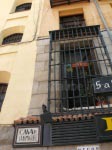
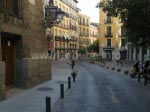
On this way, one should in any case include in the visit the Plaza Mayor, the Cava de San Miguel, the same named church and the Arco de Cuchilleros as also the streets of the surroundings. These are incomparable and of a unique flair.
Royal Buildings in "Madrid de los Austrias"
The last tour starts at the Plaza Espaņa and leads 1540m in southern direction to the Basilíca de San Francisco el Grande. Thereby, one has the opportunity to view the Jardines de Sabatini, the Palacio Real and the Catedral de la Almudena - a very recommendable sequence, as one can rapidly get ahead and can see some of the most important buildings of Madrid.
Those who do not have much time should consider a sity tour with the tourist bus company Visión Madrid. One can get out of the bus and step in again as often as wanted and the bus takes one to the most important sightseeings. Contrary to the other cities as Barcelona for example, the tourist bus is cheaper.
But those who have some days to spend in Madrid should in any case have some walks through Madrid; Narrow, romantic alleyways, nicely located bars, different building styles in hidden quarters, the flair of the oldtown - no tourist bus can transmit these impressions.
Recommendations for a stay of three days
With all these sightseeings it is difficult to pick some of them if one has a limited time period of three days. In order to avoid rishing from one place to the other, one better should postpone the excursions outside of Madrid to the next visit if one then stays in Madrid a least a week.
For stay of three full days, the following programme could be considered: the first day is the best to get an overview of the city centre. This could be, for example, the fourth tour including the Palacio Real and the Cathedral and continuing to the immediate centre at the Puerta del Sol, further to the Calle Mayor to the Plaza Mayor. As mentioned in the tour no. 5, one should in any case take the opportunity to view the Arco de Cuchilleros as also to the Cava de San Miguel with the church - a beautiful and historical view. In the evening, visit to the city district Huertas is recommendable.
The second day can be used for a museum visit, for example the Prado in conjunction with a walk through the Paseo del Prado, that also should include a visit to the botanical garden in case of plant lovers. Depending on the interest, one can either previously or afterwards do a side trip to the Museo Nacional Centro de Arte Reina Sofía (in conjunction with a visit to the station hall of Atocha) as also to the Museo Thyssen-Bornemisza. But according to my opinion, three art museums in one day are too much: at a certain time, the perception decreases. After the arts, a tour in the Retiro is unbelievably relaxing. In the evening, a tour through the oldtown is a must. An evening tour as described.
Those who are in Madrid on a Sunday should have a short look to the Rastro in order to experience this hustle and bustle. Moreover, I would use half a morning and/or afternoon in any case for a visit to the convent, the Descalzas Reales or the Monasterio de la Encarnación. Also the Casa de Campo is worthwhile to visit, maybe in conjunction with a midday picknick (depending on the season). Depending on the interests, one can either go to the theatre or musical.

Back to the index Madrid
Author: Stefanie Kotulla; Copyright 2008-2008: Patrick Wagner, www.tourist-guide.biz
|